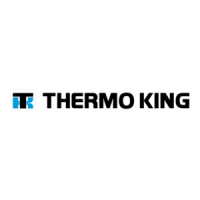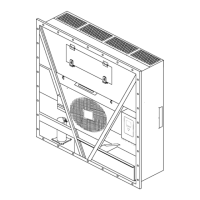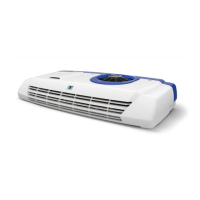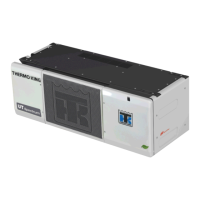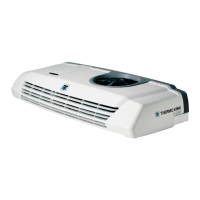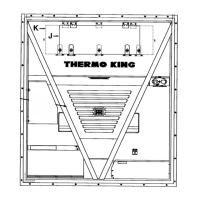
Do you have a question about the Thermo King CSR Series and is the answer not in the manual?
| Brand | Thermo King |
|---|---|
| Model | CSR Series |
| Category | Refrigerator |
| Language | English |
Essential safety guidelines for unit operation and handling.
Procedures for immediate care in case of exposure to hazardous materials or conditions.
Precautions for handling refrigerants to prevent environmental release and personal harm.
Guidelines for safe handling and preventing contact with refrigerant oil.
Critical safety measures when working with high voltage circuits to prevent electrical shock.
Immediate actions to take following an electrical shock incident.
Procedures to prevent electrostatic discharge (ESD) when servicing electronic components.
Guidelines to prevent damage to electronic circuits during welding operations.
Information on locating and understanding unit decals and serial number identification.
Recommended inspection and service intervals for electrical, refrigeration, and structural components.
Performance data for cooling and heating capacities across different models and conditions.
Airflow specifications for various models based on external static pressure.
Details on motors, voltage, and electrical resistance heater specifications.
Specifications for compressor, refrigerant charge, pressure switches, and control systems.
Technical details for the MP-3000 controller, including defrost and humidity functions.
Dimensions, weight, and fan blade specifications for various unit models.
Torque values for metric bolts and classes used in unit assembly.
Description of unit construction, features, and design for container transport.
Details on the scroll compressor system and its liquid injection cooling mechanism.
Comprehensive overview of the MP-3000 controller's capabilities, display, keypad, and data logger.
Description of dual-speed evaporator fans and the fresh air exchange system functionality.
Explanation of available options like AFAM, AFAM+, Bulb Mode, and Dehumidification Control.
Details on dual voltage capability and optional humidification control system.
Information on pressure gauges, remote monitoring, recording thermometers, and TRANSFRESH systems.
Features for monitoring and recording temperatures for USDA cold treatment compliance.
Description of the water-cooled condenser option and its fan control.
Detailed explanation of Chill Loads and Frozen Loads operating modes based on setpoints.
Description of the UNIT ON/OFF switch and the MP-3000 controller interface, including keys and displays.
Explanation of controller keys (C/F, RET/SUP, DEFROST, SETPOINT) and status indicator LEDs.
Details on evaporator overheat switch, water pressure switch, and other unit controls.
Description of instruments like oil sight glass, pressure gauges, thermistor, and remote monitor connector.
Overview of main circuit breakers, control system circuits, and fuses for unit protection.
Explanation of compressor discharge temperature sensing and high-temperature protection mechanisms.
Detailed breakdown of the MP-3000 controller's LED and LCD displays and basic features.
Explanation of the controller's keypad layout, text input, menu navigation, and special function keys.
Overview of the eight main display menus available on the MP-3000 controller.
Meaning of the eight status indicator LEDs on the MP-3000 controller display.
Functions for recording and retrieving unit operating data, alarms, and events.
Explanation of the MP-3000 controller's integrated circuits and regulated unit functions.
Detailed description of the Cool with Modulation and Heat modes for chill loads.
How supply air sensors are used for temperature control accuracy and frost protection.
Explanation of Cool, Null, and Defrost modes for frozen loads and modulation display.
Details on compressor liquid injection and high-temperature protection features.
How the controller manages evaporator fan speed and economy mode settings.
Controller's strategy for managing condenser fan operation based on ambient conditions and load.
How the controller performs a probe test to check for defective sensors.
How Bulb mode controls fan speed and defrost termination during Dehumidification.
How the dehumidify system reduces relative humidity and its control parameters.
Description of the unit's start-up sequence for cooling or heating modes.
How the controller regulates operation for chill loads, including cool mode and modulation.
A table summarizing unit functions across different modes for Chill and Frozen Loads.
How the controller manages operation for frozen loads, including Cool, Null, and Defrost modes.
How the controller provides heat by pulsing electric heaters when supply air temperature is low.
Detailed steps and conditions for the Cool mode operation.
Procedures for initiating and terminating defrost cycles, including manual defrost.
Step-by-step guide to changing the temperature setpoint on the MP-3000 controller.
How defrost cycles are initiated, terminated, and the controller's actions during defrost.
How to view alternate supply or return air sensor temperatures on the LED display.
How to switch between Celsius and Fahrenheit temperature displays.
Overview of the MP-3000 controller's main menu structure and navigation keys.
List of adjustable settings within the Setpoint menu, including temperature, mode, and AFAM parameters.
Useful tips for operating the controller, such as quick temperature changes and power management.
How to adjust the Bulb mode settings for evaporator fan speed and defrost termination.
How to configure USDA trip settings for temperature monitoring and defrost parameters.
Visual guide illustrating the flow for setting temperature, humidity, and defrost parameters.
Procedures for changing AFAM rates and CO2 maximum settings.
Steps to enable and configure Economy and Humidity control modes.
Configuration steps for Advanced Fresh Air Management system settings and options.
How to set AFAM+ system values, configure Analyzer mode, and operate AFAM/AFAM+ systems.
Procedure for setting the fresh air exchange time delay for product temperature pull-down.
How to set the desired air exchange rate for the AFAM system.
Procedure to set the desired Oxygen (O2) level for the AFAM+ system.
Procedure to set the desired Carbon Dioxide (CO2) level for the AFAM+ system.
How to access and view general unit operating information from the Data menu.
Description of the Alarms menu, including alarm types and states for diagnosis.
Steps to access and view the list of recorded alarm codes.
Explanation of alarm codes, their types, and descriptions for troubleshooting.
List of available tasks in the Commands menu, including PTI, Power Management, and Function Tests.
Steps to navigate and access the Commands menu on the controller.
How to perform a function test to automatically check individual unit components.
Detailed steps for performing a pre-trip test to check unit refrigeration, heating, and control systems.
How to perform specific diagnostic tests on individual components or systems.
How to select and adjust power limit settings and time intervals for power reduction.
List of functions for identifying trips and managing operating information like date, time, and program version.
Steps to view and set the controller's date and time accurately.
Procedures for resetting or setting operating hours for the unit and its components.
How to enter essential trip information such as container ID, contents, and shipping details.
How to switch the temperature display between Celsius and Fahrenheit.
Overview of available configuration settings for unit features, options, and language.
List of functions for inspecting temperature logs, event logs, PTI logs, and calibrating USDA probes.
How to view recorded temperature logs and event flags for unit operation analysis.
How to view event logs for alarms, power status, setpoint changes, and defrost events.
Procedures for calibrating USDA sensors using an ice bath to ensure accurate temperature recording.
Detailed steps for calibrating USDA sensors in an ice bath to ensure accurate readings.
How to activate and log the start time and date for a trip.
How to configure the data logging interval for temperature and event logs.
Procedures for viewing event logs and understanding event examples.
How to check the communication status with the REFCON system via the Remote Monitoring Modem.
Procedures for operating the unit manually in case of controller failure.
Steps to reverse power phase for correct fan rotation on CSR units.
Step-by-step guide for replacing the MP-3000 controller, including software selection.
How the controller automatically configures based on installed unit options.
Guide to selecting the correct software for the controller based on unit type and dial position.
Procedures for updating controller software using flash loading.
Description of thermistor sensors used and their typical locations.
Proper procedures for installing supply air, return air, and evaporator coil sensors.
Tables providing resistance values for various sensors at different temperatures.
Specific instructions for locating and positioning the condenser coil sensor.
Table of conditions, possible causes, and remedies for mechanical issues.
Troubleshooting for compressor contactor burnout, short cycling, noisy operation, and condenser fan motor faults.
Troubleshooting for evaporator fan faults and unit not cooling due to various refrigerant system issues.
Diagnosing low or high head pressure, compressor oil loss, and rapid cycling.
Troubleshooting for issues related to hot liquid lines, frosted lines, and expansion valve problems.
Diagnosing problems related to vacuum levels, frosted expansion valves, and suction pressure.
Description of the AFAM system for programmable air exchange control.
How to configure AFAM system settings like units, delay, and rate.
Steps to start and operate the AFAM system.
How to adjust the AFAM delay to allow faster product temperature pull-down.
Procedure for setting the desired air exchange rate for the AFAM system.
How to set AFAM system units (CFM, M3H, PERCENT) within the controller's configuration.
Overview of the AFAM+ system for controlling O2 and CO2 levels.
Configuration steps for AFAM+ system, including O2 Min and CO2 Max settings.
Steps to start and operate the AFAM+ system.
Adjusting the AFAM delay to control vent door opening after unit startup.
Procedure to set the desired minimum Oxygen (O2) level for the AFAM+ system.
Procedure to set the desired maximum Carbon Dioxide (CO2) level for the AFAM+ system.
